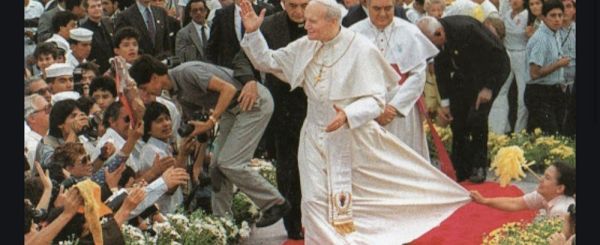1. With my gaze turned to the Shroud, I would like to extend a cordial greeting to you all, the faithful of the Church of Turin. I greet the pilgrims who have come from every part of the world at the time of this public exposition to look at one of the most unsettling signs of the Redeemer's suffering love.
As I entered the cathedral, which still shows the scars of last year's terrible fire, I paused in adoration before the Eucharist, the sacrament which is the focus of the Church's attention and, under humble appearances, contains the true, real and substantial presence of Christ. In the light of Christ's presence in our midst, I then stopped before the Shroud, the precious Linen that can help us better to understand the mystery of the love of God's Son for us. Before the Shroud, the intense and agonizing image of an unspeakable torment, I wish to thank the Lord for this unique gift, which asks for the believer's loving attention and complete willingness to follow the Lord.
3. For the believer, what counts above all is that the Shroud is a mirror of the Gospel. In fact, if we reflect on the sacred Linen, we cannot escape the idea that the image it presents has such a profound relationship with what the Gospels tell of Jesus' passion and death, that every sensitive person feels inwardly touched and moved at beholding it. Whoever approaches it is also aware that the Shroud does not hold people's hearts to itself, but turns them to him, at whose service the Father's loving providence has put it. Therefore, it is right to foster an awareness of the precious value of this image, which everyone sees and no one at present can explain. For every thoughtful person it is a reason for deep reflection, which can even involve one's life. The Shroud is thus a truly unique sign that points to Jesus, the true Word of the Father, and invites us to pattern our lives on the life of the One who gave himself for us.
7. The Shroud is an image of silence. There is a tragic silence of incommunicability, which finds its greatest expression in death, and there is the silence of fruitfulness, which belongs to whoever refrains from being heard outwardly in order to delve to the roots of truth and life. The Shroud expresses not only the silence of death but also the courageous and fruitful silence of triumph over the transitory, through total immersion in God's eternal present. It thus offers a moving confirmation of the fact that the merciful omnipotence of our God is not restrained by any power of evil, but knows instead how to make the very power of evil contribute to good. Our age needs to rediscover the fruitfulness of silence, in order to overcome the dissipation of sounds, images and chatter that too often prevent the voice of God from being heard.
[Pope John Paul II, Veneration of the Shroud, Turin 24 May 1998]












